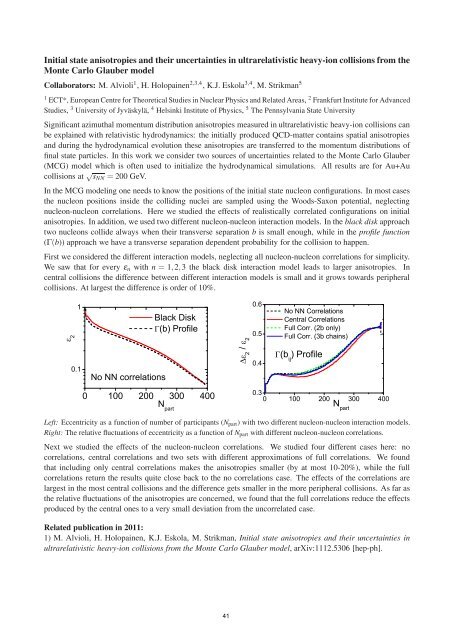FIAS Scientific Report 2011 - Frankfurt Institute for Advanced Studies ...
FIAS Scientific Report 2011 - Frankfurt Institute for Advanced Studies ...
FIAS Scientific Report 2011 - Frankfurt Institute for Advanced Studies ...
You also want an ePaper? Increase the reach of your titles
YUMPU automatically turns print PDFs into web optimized ePapers that Google loves.
Initial state anisotropies and their uncertainties in ultrarelativistic heavy-ion collisions from the<br />
Monte Carlo Glauber model<br />
Collaborators: M. Alvioli 1 , H. Holopainen 2,3,4 , K.J. Eskola 3,4 , M. Strikman 5<br />
1 ECT*, European Centre <strong>for</strong> Theoretical <strong>Studies</strong> in Nuclear Physics and Related Areas, 2 <strong>Frankfurt</strong> <strong>Institute</strong> <strong>for</strong> <strong>Advanced</strong><br />
<strong>Studies</strong>, 3 University of Jyväskylä, 4 Helsinki <strong>Institute</strong> of Physics, 5 The Pennsylvania State University<br />
Significant azimuthal momentum distribution anisotropies measured in ultrarelativistic heavy-ion collisions can<br />
be explained with relativistic hydrodynamics: the initially produced QCD-matter contains spatial anisotropies<br />
and during the hydrodynamical evolution these anisotropies are transferred to the momentum distributions of<br />
final state particles. In this work we consider two sources of uncertainties related to the Monte Carlo Glauber<br />
(MCG) model which is often used to initialize the hydrodynamical simulations. All results are <strong>for</strong> Au+Au<br />
collisions at √ sNN = 200 GeV.<br />
In the MCG modeling one needs to know the positions of the initial state nucleon configurations. In most cases<br />
the nucleon positions inside the colliding nuclei are sampled using the Woods-Saxon potential, neglecting<br />
nucleon-nucleon correlations. Here we studied the effects of realistically correlated configurations on initial<br />
anisotropies. In addition, we used two different nucleon-nucleon interaction models. In the black disk approach<br />
two nucleons collide always when their transverse separation b is small enough, while in the profile function<br />
(Γ(b)) approach we have a transverse separation dependent probability <strong>for</strong> the collision to happen.<br />
First we considered the different interaction models, neglecting all nucleon-nucleon correlations <strong>for</strong> simplicity.<br />
We saw that <strong>for</strong> every εn with n = 1,2,3 the black disk interaction model leads to larger anisotropies. In<br />
central collisions the difference between different interaction models is small and it grows towards peripheral<br />
collisions. At largest the difference is order of 10%.<br />
�<br />
�<br />
���<br />
������������������<br />
�<br />
� ��� ��� ��� ���<br />
�<br />
�����������<br />
� �����������<br />
� ����<br />
�<br />
���<br />
���<br />
���<br />
�������������������<br />
���������������������<br />
���������������������<br />
�����������������������<br />
�� �� ���������<br />
�<br />
���<br />
� ��� ��� ��� ���<br />
Left: Eccentricity as a function of number of participants (Npart) with two different nucleon-nucleon interaction models.<br />
Right: The relative fluctuations of eccentricity as a function of Npart with different nucleon-nucleon correlations.<br />
Next we studied the effects of the nucleon-nucleon correlations. We studied four different cases here: no<br />
correlations, central correlations and two sets with different approximations of full correlations. We found<br />
that including only central correlations makes the anisotropies smaller (by at most 10-20%), while the full<br />
correlations return the results quite close back to the no correlations case. The effects of the correlations are<br />
largest in the most central collisions and the difference gets smaller in the more peripheral collisions. As far as<br />
the relative fluctuations of the anisotropies are concerned, we found that the full correlations reduce the effects<br />
produced by the central ones to a very small deviation from the uncorrelated case.<br />
Related publication in <strong>2011</strong>:<br />
1) M. Alvioli, H. Holopainen, K.J. Eskola, M. Strikman, Initial state anisotropies and their uncertainties in<br />
ultrarelativistic heavy-ion collisions from the Monte Carlo Glauber model, arXiv:1112.5306 [hep-ph].<br />
41<br />
� ��� �<br />
�<br />
� ����
















